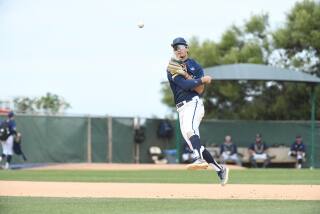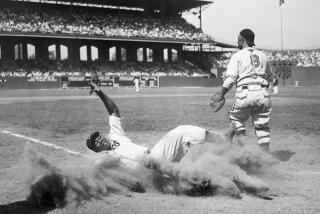Dickey a Rarity in College Baseball
- Share via
Gavin Dickey stuck with baseball even while his friends gave up on the sport. Now, as the starting left fielder during Florida’s run to the championship round of the College World Series, he’s part of an ever-dwindling minority.
He’s a black college baseball player.
“Growing up, a lot of my friends opted for other sports, like football or basketball, the bigger crowds, the more spotlight sports,” said Dickey, who also serves as the backup quarterback for the football Gators. “I loved the game of baseball growing up. It was always fun to me, and it’s a challenge.”
Perhaps the biggest challenge was simply making it as far as he did. In 2003-04 -- the most recent data compiled by the NCAA -- only 6 percent of the nearly 9,800 Division I baseball players were black, compared to 25 percent in all sports combined. Whites made up 84 percent of the baseball rosters.
And the total number of black baseball players has fallen from a five-year high of 649 in 2001-02 to 598 last year.
“It’s sad, because I remember when I was this age, there were a lot of guys getting opportunities to go,” said Harold Reynolds, a two-time All-Star during his 12-year career in the majors and currently an analyst for ESPN’s baseball coverage.
As expected, basketball and football are much more equitable. Half of the men’s and women’s basketball players were black, and 44 percent of the football players.
“I think it’s a reflection of the fact that there aren’t any African-Americans at the lower levels of baseball,” said Richard Lapchick, the director of the Institute for Diversity and Ethics in Sports at the University of Central Florida. “If baseball is going to be seen as the national pastime, you would hope it would reflect the diversity of the country.”
According to Lapchick, the number of black players in the majors this season is down to 9 percent, the lowest figure since the late 1970s.
Major league baseball spends about $3 million a year on several programs to draw minorities to the game, including Rookie League and Reviving Baseball in Inner Cities (RBI). It also helped build a Youth Baseball Academy in Compton, and assisted the Braves in constructing a similar facility in Atlanta.
All this appears to be working, at least for professional baseball. This season, a record 31 RBI participants were selected in the amateur draft, including top pick Justin Upton from Chesapeake, Va. That’s up from 22 last year, and the total since RBI started 16 years ago is close to 150.
But, so far, it hasn’t done much for the colleges. Arizona State, Oregon State and Texas all made the College World Series this season without a single black player on their rosters.
“It’s something very important to me,” said Florida coach Pat McMahon. “It’s important to me that each and every young man has an opportunity to play.”
Reynolds played at Long Beach State before getting drafted in 1980 by the Seattle Mariners, and he clearly is passionate about this issue. He blames the lack of scholarships -- Division I teams are limited to 11.7 total for their rosters -- and the proliferation of suburban-based travel teams around the country, where some play in as many as 65 games over the summer.
And he also wonders if the culture has changed.
“When I was a kid, everybody was playing all the sports,” Reynolds said. “You got coaches now who say if you want to play on my high school basketball team, you’ve got to play basketball in the summer. Now you’re cutting out the kids’ options to play baseball.”
That even includes historically black colleges and universities. This season, North Carolina A&T; won the Mid-Eastern Athletic Conference championship and advanced to the NCAA tournament for the first time, all with about half of its roster made up of whites.
The Aggies’ coach, Keith Shumate, who also is white, was selected as coach of the year by Black College Baseball, a Web site devoted to schools such as A&T.;
More to Read
Go beyond the scoreboard
Get the latest on L.A.'s teams in the daily Sports Report newsletter.
You may occasionally receive promotional content from the Los Angeles Times.










